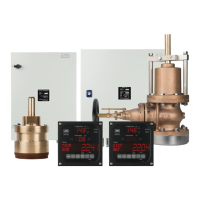2-4
The beam travels down to the sea bed with a velocity of close to 1500 m/s. This velocity is
almost constant for different frequencies. If we have a calibrated depth meter, we may have to
compensate for salinity, density and temperature differences. The SOG correlation speed logs
operate at 150 kHz, giving a wavelength of 10 mm.
1.2 Depth measurement
The depth measurement is divided into two phases: first we seek the depth by transmitting a
pulse and wait for the echo to return. Once the depth has been measured we use a locked loop
to adjust the depth to correct value.
1.2.1 Seek mode
In the six predefined seek modes the log transmits a pulse. The pulse length varies between 0.3
and 67 ms corresponding to seek ranges from minimum depth 1 to maximum depth 400 meters.
After the transmit pulse the receiver is sampled at regular intervals. The echo will have the
same length as the transmitted pulse. The log correlates the transmitted pulse with the echo to
form an echo function. The peak of this function corresponds to the time it takes for the pulse
to travel from the hull to the sea-bed and back. If a valid echo is found the log enters the depth
lock mode.
Depth seek mode
ransmit pulse
Echo signal
Sampling
2 * Depth / C
1.2.2 Lock mode
In the depth lock mode we use the known depth value to measure the depth more accurately.
The depth lock mode is divided into 9 cycles, see figure below. During cycle 1 a pulse is
transmitted. The length of this pulse is equal to the time it takes for the wave to travel from the
transducer to the sea bottom. During cycle 2 this signal travels back to the transducer. During
cycle 3 the echo pulse is active on the transducer elements. The positive edge of the returned
echo is locked to always come at start of cycle 3, se figure below.

